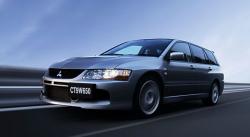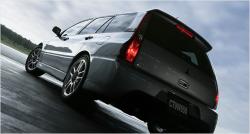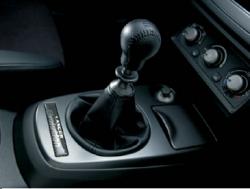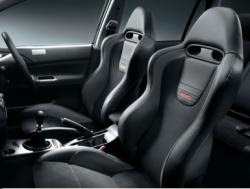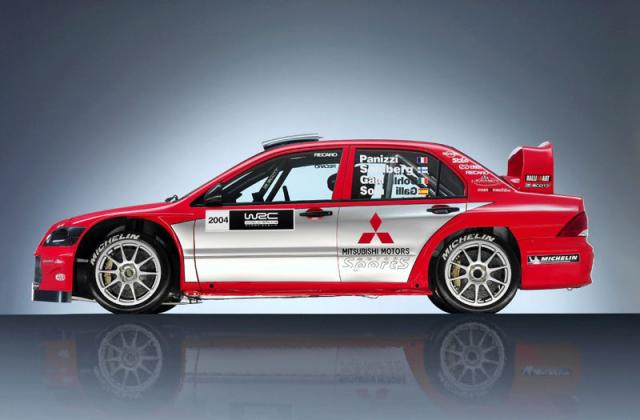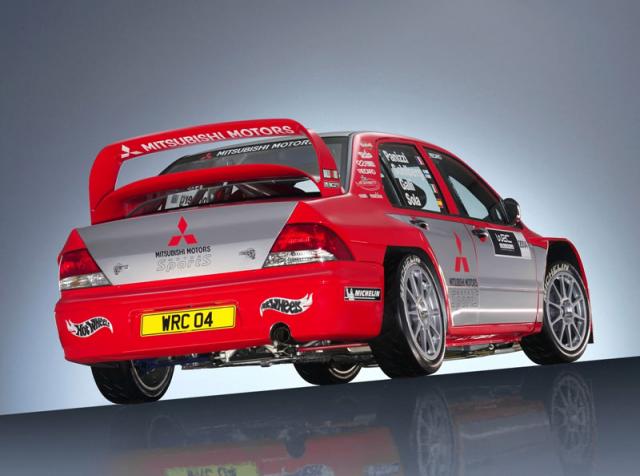Search the Community
Showing results for tags 'evolution'.
-

Mitsubishi Evolution driver gets praises for his parking offence
chitchatboy posted a blog entry in MyAutoBlog
Someone has spotted this chrome-wrapped Mitsubishi Evolution 9 MR parking at some motorcycle lots and sent it to SG Road Vigilante. The photo, which was taken on 30th of May 2020, obviously shows the Mitsubishi Evo occupying lots intended for motorcycles. You might be wondering why we are sharing this with you as HDB parking offences are not that big a deal as it is a common occurrence. In fact, we reckon most of us should have some form committed parking offences before and simply sort out our mistake by making an appeal for the parking offence. What is interesting however, are the comments on this photo on SGRV's facebook post, there were more netizens praising how cool the Evo looked or how rare the car is instead of the usual slamming and shaming comments. Don't you love our local car community? -

Mitsubishi's Lancer Evolution making a comeback again?
chitchatboy posted a blog entry in MyAutoBlog
Mitsubishi has said before that it is not intending on making another Lancer Evolution. But there are reports that a new one is in the works. According to Autocar's article, it claimed that Mitsubishi is planning to revive the Lancer Evolution and build an 11th-generation model, as it found out from unnamed “Japanese-based sources”. It explained that Mitsubishi wants to spice up its lineup and try to cater to the enthusiasts. Using the CMF-C/D F4 platform from the Renault-Nissan-Mitsubishi Alliance and parts that could be shared with the next-generation Megane R.S., the new Evo might sound like a possibility. While some reports cited that the car could be powered by a turbocharged 2.0-litre four-cylinder paired with the addition of a 48-volt mild-hybrid system, others said that it could use the existing 1.8-litre turbocharged lump found in the current Megane R.S.- 1 comment
-
- mitsubishi
- lancer
-
(and 2 more)
Tagged with:
-
Mitsubishi set to resurrect Lancer Evolution Source: https://www.motoring.com.au/mitsubishi-set-to-resurrect-lancer-evolution-119217/ Reborn Japanese hero to share its underpinnings with Renault Megane RS, according to fresh reports The Mitsubishi Lancer Evolution is set for a rebirth. British publication Autocar reports the cult-favourite Japanese sports car will be revived under the alliance between Mitsubishi and Renault. Continuing a rich history kicked off by the first-generation model in 1992, the Lancer Evolution XI is set to offer “supercar-beating acceleration together with the choice of either traditional four-door saloon or five-door hatchback bodystyles,” according to Autocar, which cites Japanese-based sources. The newcomer will reportedly share elements of its drivetrain with the next-generation Renault Megane RS, using a turbocharged 1.8-litre four-cylinder engine mated to a dual-clutch gearbox and an advanced Mitsubishi-developed S-AWC four-wheel drive system. Presently, the Megane RS engine makes 224kW and 420Nm in its most powerful Trophy-R trim similar outputs to the 226kW/414Nm Evolution X that was retired in 2015. However, the possible addition of electronic boosting in a 48V mild-hybrid system being developed for the Renault-Nissan-Mitsubishi alliance is likely to increase its reserves,” the article claims. The 11th generation of the four-wheel-drive Lancer Evolution has been conceived to sit on the CMF-C/D F4 platform developed within Renault-Nissan-Mitsubishi. The Evolution’s revival is reportedly part of Mitsubishi chairman Osamu Masuko’s plans to restore the Japanese car-maker’s famous performance status. Seventy-year-old Masuko is set to relinquish his position as Mitsubishi chief executive to Takao Kato. However, the Mitsubishi veteran will continue to lead the company in the position of chairman. Previous plans by Masuko to develop a successor to the Mitsubishi Lancer Evolution X were placed on hold following heavy losses at the company and its subsequent purchase by Nissan in 2016.
- 1 reply
-
- 2
-

-
- mitsubishi
- lancer
- (and 4 more)
-
Good day brothers and sisters.. It's been long since I last appeared here in MCF.. I'm just curious.. Just got a white EVO 9 GSR not too long ago.. Just renewed COE for it.. Any other EVO owners around here in MCF? Will be nice to learn from you guys..
- 35 replies
-
- 5
-

-
- mitsubishi
- evo 9
- (and 6 more)
-
I would like to say hi to everyone in this forum and here is my previous evolution gsr tommi makkinen edition with beautiful carbon fiber bonnet right in front of the vehicle.Those ugly stickers have been removed completely outside from the whole part and repaint back to the red shade on the exterior but remain original paint inside there.Please check it out on the scans below and let me know what you think there.Thank you
- 5 replies
-
- mitsubishi
- beautiful show piece
- (and 7 more)
-
- 12 replies
-
- mitsubishi
- mitsubitshi
-
(and 3 more)
Tagged with:
-
btw, is there another local forum doing / having about the same online talks etc as MCF? MCF has evolved from a car forum to _______ ? from chats n tkss to still chats n tkss or ___________? but always tells the pains, truth, richness, etc and ________?
-
Rumours about the next generation Mitsubishi Evolution to be a hybrid has been going around for quite some time and there were also rumours about Mitsubishi scrapping the model totally and focusing on electric vehicles. But now Mitsubishi have made a U-turn and confirmed that the next generation Evolution will feature a hybrid powertrain. Mitsubishi president, Osamu Masuko, recently announced that the company is starting on the new hybrid Evolution project next year and it will be ready within the next three years. He also added that Mitsubishi has set the goal of developing a sports car featuring electric power. What
-
lol jus sharing bmw http://cllctr.com/image/cbf865003899f6d5ae930dd8b6e58280/576 mercedes http://cllctr.com/image/0b9670d3861bf0eb9f0fcf51a1fe40dd/312 audi http://cllctr.com/image/64f817aa66a4db93b02462afa2e08e1b/576 also the others like alfa romeo vw and the rest http://cllctr.com/view/6b096c14156c94890a9...906c8d3/related
-
Some say men started off as apes etc and became human beings along the way......... SGP drivers started off as proper drivers if I remember correctly, then evoloution kicked in and some of them become:- 1. No need signals before turning, or changing lane 2. See car in front signal to change lane, quickly speed up to close the gap so that he cant change 3. Road hog 4. Tailgate 5. .... the list goes on.. Today as I approached a junction, I saw an auntie driver waiting in lane 1 at traffic light (this lane can go either straight or turn right), she's the first in that lane. Experience told me better not wait behind her even though she didnt 'on' her right turn signal lights and lane 2 already had few cars queuing at the red light to go striaght. So I joined the queue in lane 2. Then another car came and didnt like the queue in lane 2 and waited behind her thinking she would go straight.... When the lights turned green...... she "on" her right turn signal lights!!! ...... the driver who were 'caught' by this "evolutioned" aunty driver LL ended up waiting..... These 'no-need or late' signal drivers must be trying to preserve the life span of their signal light bulbs....
-
Mistubishi
- 27 replies
-
- 2008
- Mitsubishi
-
(and 1 more)
Tagged with:
-
Anyone who has added this to their rides, please comment.... I am considering these and am a newbie in modding....
-
Hi I joined the forum to learn a bit more about cars. I bought a used Evo VIII from a dealer in Bangkok and a test revealed that it's got many problems. Now I want to try to get them fixed and learn a bit about it at the same time. Here is a list of all the issues. For a start maybe someone can comment on what the most important thing to fix would be, the most dangerous, etc .. Engine - damaged oil sump - deteriorated drive belt Fuel System - bent fuel pipe under - dent intercooler Exhaust system - deteriorated exhaust pipe mount rubber Suspension - deteriorated rear arm bush Chassis and body - dented front left door - dented front right door - dented rear left door - dented rear right door - fits poorly boot-trunk seal - fits poorly front right door adjust - general paint and body work poor condition - lose shape door trunk seal - missing under engine panel - repainted body - repaired A, B, C-pillar high - repaired body engine compartment - repaired front cross member lower upper - repaired front left fender high - repaired front right fender high - repaired rear left fender high - repaired rear right door high - repaired rear right fender high - repaired roof high - repaired trunk lid high - replace rear structure body - scrape / dent longitudation member Braking system - bent brake pipe under - parking brake retardation is below limit value Tires - missing spare wheel - nail stab rear right tire - scraped rim Electric System - broken combination light - defective battery - defective from wiper system - front and rear nozzle washers do not work - headlight direction not correct Transmission - oil leak from gearbox Interior - loose front console box - loose front left side panel cover plastic - loose rear left side panel cover plastic - missing rear safety belt - scratch front console
- 42 replies
-
- Mitsubishi
- Lancer
- (and 6 more)
-
Anyone saw that special yellow boxy Merc with full bodykit (trying to be an Evo lookalike), GT wing, vented bonnet and VORTEX GENERATOR????!!!! I saw it twice but did not snap pics (unfortunately)!!! Hero!!!
-
One hero white evoluton, cutting thru the lanes, speeding in excess of 100km/h pass shell and into the roundabout at serangoon gardens causing many vehicles to jam brake etc. Few minutes later, take corner after the pub area leading to worthing road, slam right into school gate. out walks a bleeding young kid no more than 25 whom imho looks beng with slightly long hair and looks in a daze. dunno drunk or disoriented. neighbours rush out to give aid. another evo gone. lucky he smash himself into a school. what if he killed another? i have seen racers but this was really hollywood movie style. damn hero. i admire his guts to smash an evo. happened slightly past 12.15 a.m. sorry, no pics.
-
Ya ... you read correctly.... WAGON Mit Evo Mivec Turbo 6 Speed Manual or 5 speed Auto (GT-A) [inline evowagon1.jpg] [inline evowagon2.jpg] [inline evowagon3.jpg] [inline evowagon4.jpg] [inline evowagon5.jpg] [inline evowagon6.jpg] [inline evowagon7.jpg]
- 36 replies
-
- Mitsubishi
- Evolution
-
(and 1 more)
Tagged with:
-
Michelin Tweels. [michelintweel] In 2005, Michelin unveiled their "Tweel" concept - a word made up of the combination of Tyre and Wheel. After decades of riding around on air-filled tyres, Michelin would like to convince us that there is a better way. They're working on a totally air-less tyre. Airless = puncture proof. The Tweel is the creation of Michelin's American technology centre - no doubt working with the sound of the Ford Explorer / Bridgestone Firestone lawsuit still ringing in their ears. The Tweel is a combined single-piece tyre and wheel combination, hence the name, though it actually begins as an assembly of four pieces bonded together: the hub, a polyurethane spoke section, a "shear band" surrounding the spokes, and the tread band - the rubber layer that wraps around the circumference and touches the road. The Tweel's hub functions just like your everyday wheel right now - a rigid attachment point to the axle. The polyurethane spokes are flexible to help absorb road impacts. These act sort of like the sidewall in a current tyre. But turn a tweel side-on and you can see right through it. The shear band surrounding the spokes effectively takes the place of the air pressure, distributing the load. Finally, the tread is similar in appearance to a conventional tyre. The image on the right is my own rendering based on the teeny tiny images I found from the Michelin press release. It gives you some idea what the new Tweel could look like. One of the basic shortcomings of a tyre filled with air is that the inflation pressure is distributed equally around the tire, both up and down (vertically) as well as side-to side (laterally). That property keeps the tire round, but it also means that raising the pressure to improve cornering - increasing lateral stiffness - also adds up-down stiffness, making the ride harsher. With the Tweel's injection-molded spokes, those characteristics are no longer linked. Only the spokes toward the bottom of the tyre at any point in its rotation are determining the grip / ride quality. Those spokes rotating around the top of the tyre are free to flex to full extension without affecting the grip or ride quality. The Tweel offers a number of benefits beyond the obvious attraction of being impervious to nails in the road. The tread will last two to three times as long as today's radial tires, Michelin says, and when it does wear thin it can be retreaded. For manufacturers, the Tweel offers an opportunity to reduce the number of parts, eliminating most of the 23 components of a typical new tire as well as the costly air-pressure monitors now required on all new vehicles in the United States. (See TPMS below). Another benefit? No spare wheels. That leaves more room for boot/trunk space, and reduces the carried weight in the vehicle. Reporters who took the change to drive an Audi A4 sedan equipped with Tweels early in 2005 complained of harsh vibration and an overly noisy ride. Michelin are well aware of these shortfalls - mostly due to vibration in the spoke system. (They admit they're in extremely-alpha-test mode.) Another problem is that the wheels transmit a lot more force and vibration into the cabin than regular tyres. A plus point though is cornering ability. Because of the rigidity of the spokes and the lack of a flexing sidewall, cornering grip, response and feel is excellent. There are other negatives: the flexibility, at this early stage, contributes to greater friction, though it is within 5% of that generated by a conventional radial tyre. And so far, the Tweel is no lighter than the tyre and wheel it replaces. Almost everything else about the Tweel is undetermined at this early stage of development, including serious matters like cost and frivolous questions like the possibilities of chrome-plating. Either way, it's a promising look into the future. Tweels are being tested out on the iBot - Dean Kamen's (the Segway inventor) new prototype wheelchair, and by the military. The military are interested because the Tweel is incredibly resistant to damage, even caused by explosions. Michelin hope to bring this technology to everyday road car use, construction equipment, and potentially even aircraft tyres.
-
Source: Mitsubishi Cars For 2004, Lancer Evolution buyers may opt for leather front Recaro® seats, and they may opt for a 315-watt Infinity® sound system, complete with subwoofer. A limited number of brave souls may also opt for the latest trim level, the Mitsubishi Lancer Evolution RS. If the lightweight, turbocharged, all-wheel-drive Lancer Evolution was not the right car for you, then the Lancer Evolution RS is even less right. But for racing purists, compact car tuners and hard-core driving enthusiasts, the best bang-for-the-buck sports sedan just got better. Thanks to numerous weight-saving measures, the Lancer Evolution RS tips the scales nearly 150 pounds lighter than the Lancer Evolution. Its featherweight status notwithstanding, the RS has also been blessed with quicker reflexes: a front helical-type limited slip differential and a rear crossbar help to improve the handling of one of the world's best-handling automobiles. "Lancer Evolution RS reflects the essence of high-performance value," said Finbarr O'Neill, co-chairman and chief executive officer of Mitsubishi Motors North America, Inc. (MMNA). "We've boiled the cost-per-thrill ratio down to its lowest conceivable point, providing tuners and racing enthusiasts with more of what they need, and less of what they don't." Less is More When the difference between winning and losing can be measured in tenths of a second, the difference between the 3,321-lb Lancer Evolution and the 3,175-lb Lancer Evolution RS becomes significant. To achieve a curb weight lower than the already-lean Lancer Evolution, the Lancer Evolution RS sheds several non-essential items. Most notable from outside, the RS is not bedecked with the Lancer Evolution's distinctive rear wing spoiler. The high-intensity discharge headlights also were deleted, as was the rear window wiper. Inside, RS drivers must make do without an air conditioning system or an AM/FM/CD audio system. There are no power mechanisms for the windows, locks, or side mirrors. Trunk compartment trim has been removed, as have vanity mirrors, rear assist grips, map lamps, and the parking brake lever's leather covering. An antilock brake system is not available. There are also fewer color choices; the Lancer Evolution RS is available in Rally Red or Weightless White. A Differential Difference The Lancer Evolution RS doesn't compromise performance, whether performance is defined as straight-ahead acceleration or exit speed out of an apex. Higher performance is achieved in part by lowering the vehicle's mass, but the RS is also better equipped to handle lateral motion, thanks to the addition of its front limited slip differential. This helical limited slip differential (LSD) takes the place of the Lancer Evolution's open front differential, giving the RS mechanical front and rear differentials that split power delivery between their respective left and right wheels, and a center differential that splits the power between front and rear. The front differential's helical design provides it with smooth operation and superior responsiveness. Small in both size and weight, the helical unit does not require special oil or additional maintenance. Helical-type limited-slip differentials offer several advantages over the clutch-type or viscous LSDs. Viscous limited-slip units tend to wear out after extended use, as their oil is heated and reheated until it degrades, rendering the unit ineffective. Clutch-type differentials provide good off-the-line traction, but the 50/50 stability that's beneficial in a straight line is not so desirable when a vehicle is turning. The helical-type limited slip provides better durability and performance when it's needed most: while turning. Unlike an open differential, which shifts power to the wheel with less grip, the helical LSD constantly shifts the bias toward the wheel that has more traction. Under straight-line acceleration, power remains evenly split between the front wheels. While cornering (e.g. accelerating out of a turn), the helical LSD directs power away from the inside wheel and toward the outside wheel, allowing the driver to begin accelerating earlier and exit the turn at a higher speed, without losing traction in the process. Performance is also improved on slippery mud or snow that's often encountered on isolated dirt roads, where the Lancer Evolution series spent much of its development. Curb Weight: 3175 lbs Layout: Front-Engine/AWD Transmission: 5-Speed Manual Engine Type: Turbocharged Inline-4 Displacement: 1997 cc Horsepower: 271 bhp @ 6500 rpm Torque: 273 lb-ft @ 3500 rpm Redline: 7000 rpm
- 57 replies
-
- 2004
- Mitsubishi
-
(and 2 more)
Tagged with:
-
Mitsubishi Motors motor sports subsidiary, MMSP, unveils the car that will spearhead its 2004 FIA World Rally Championship campaign, the Mitsubishi Lancer WRC04. A completely fresh design, the new car forms an integral part of a meticulously conceived long-term plan to build on MMSP
- 24 replies
-
- Mitsubishi
- Lancer
-
(and 2 more)
Tagged with:
-
Hi people, Need to check a few things with anyone out there who might have answers to ANY of these questions. 1. 16" Crono Evolution 4x100 ET? 6.5" or 7"? 6.2kg correct? 2. 16" Superlegs weight? ET? Thanks. Doing a general comparison. I've NO IDEA what's 5 kg or 6 kg like actually, I can only imagine the relative weight of one vs. another...
-
http://www.supercars.net/PicFetch?pic=2003_mitsubishi_lancer_evo_viii_fq300-1.jpg http://www.supercars.net/PicFetch?pic=2003_mitsubishi_lancer_evo_viii_fq300-2.jpg Universally acclaimed for its raw power, exceptional handling and an emotionally spine-tingling driving experience, the new generation Mitsubishi Lancer Evolution VIII is about to hit the streets of Europe. In the last few months, Mitsubishi's motorsport and performance car division, Ralliart, has been moved in-house. Now part of the Mitsubishi Motors Corporation and Mitsubishi Motors Europe operation, Ralliart is to become a premium sub-brand. Mitsubishi Motors in the UK is the sole importer and supplier of official Ralliart products and accessories. Available in two specifications and with a top speed of 157mph, power output for the new Evo VIII is 276bhp as standard. However, for those customers who like a little more under the bonnet the FQ-300 performance package, developed in conjunction with the Mitsubishi World Rally Team, boosts power to in excess of 300bhp. The Mitsubishi Evolution series is all about continuous enhancement using performance technology and the new Evo VIII delivers on all counts. Improvements on its predecessor include the addition of Super AYC (Active Yaw Control) and a 6-speed close ratio gearbox; extensive improvements to and tuning of the engine, suspension and aerodynamics; a stiffer body and extensive reductions in weight. The result - the new Lancer Evolution VIII reaches new dimensions of on-road performance and driving exhilaration. Under the bonnet Beneath the Evo VIII's bonnet is Mitsubishi's latest version of the high-performance 4G63 2.0-litre intercooled turbocharged 4 cylinder, DOHC 16-valve engine that boasts unmatched levels of maturity and refinement. Producing 276 bhp in standard tune at 6,500rpm, whilst delivering a class-topping 289 lb ft of torque at 3,500rpm. By adopting a 6-speed close ratio gearbox, maximum response from the engine and transmission is retained throughout the broad powerband. For the Evo VIII, Mitsubishi has further developed its famous 4G63 type 2.0-litre engine by redesigning the turbocharger, increasing the capacity of the intercooler and redesigning the intake manifold to reduce air-flow resistance by 20%. A 3-nozzle intercooler jet system sprays water on to the front of the intercooler which helps cool the compressed air going through the intercooler providing more power under hard acceleration. Engine durability and reliability have also been improved by up-rating the aluminium pistons and forged steel con rods. These detail improvements result in an engine that combines competition-ready but street-friendly power with outstanding durability. The exhaust pipe has been straight-lined to reduce exhaust back pressure and a variable back pressure valve has been added to the main silencer to improve quietness at low engine speeds. The combined fuel consumption figure for the Evo VIII is 20.5 mpg and CO2 is 334 g/km. Top speed is restricted to 157 mph and the official factory 0-62mph time has been given as a 'conservative' 5.3 seconds. The FQ-300 performance package statistics have yet to be officially confirmed, but early indications point to power in excess of 300bhp, an equally impressive torque exceeding 300lb.ft. and a 0-62 time of 4.9 seconds. Mitsubishi's advanced 4WD system The Lancer Evolution VIII has a revised suspension system, slightly lower slung to get the centre of gravity lower. A revised ACD (Active Centre Differential) and rear limited slip differential are used in conjunction with the new Super AYC (Active Yaw Control). Debuting on Evo VIII, the new Super AYC realises significant performance improvements. After carefully calculating torque requirements under simulated race conditions, Super AYC has been developed to transfer twice the torque of the current AYC. The ability to transfer more torque between the rear wheels further reduces understeer while extending cornering limits (in-house skid-pad testing has shown that Super AYC extends Evo VIII's cornering limit by 10% over the current system). Super AYC also acts like a limited slip differential by increasing inside wheel traction in race circuit and other high speed cornering situations, thereby preventing the wheel slip that can occur with the current system due to its smaller torque transfer capacity. ACD enhances acceleration and straight line stability. An electronically controlled multi-layer hydraulic clutch replaces the conventional VCU as the differential limiter, controlling front/rear drive power distribution on the centre differential and switching from free to direct-link status to maintain its front/rear drive force setting of 50:50 distribution while matching the driving conditions. This achieves a tuned balance between handling response and drive performance of the highest level. In addition, the driver can switch between the 3-modes TARMAC, GRAVEL, or SNOW settings, while the car is moving, to optimise control and to match road conditions. A computer controls the new active centre differential (ACD) and super active yaw control (AYC) systems with the ACD maximising performance when accelerating out of a corner, and AYC supporting performance during cornering. This new integrated control system provides better overall stability and performance compared to systems that control ACD and AYC independently. Transmission The new generation Evo VIII is the first to be given a 6-speed manual transmission. The 6-speed close ratio gearbox has been developed in order to maximise extra torque generated by the revised 4G63 2.0-litre intercooled turbocharged 4 cylinder, DOHC 16-valve engine. The close ratio set up maximises engine performance throughout its entire range but with improved flexibility at low to medium speeds. Outside and in In keeping with its principles, exterior restyling has not been about simple cosmetic improvement. Reducing drag and lift, the Evo VIII's new exterior lines give it better high-speed straight line stability and handling through corners and features significant advances in aerodynamic and cooling performance. The new exterior incorporates the defining elements of Mitsubishi's new design identity. A significantly restyled and more aggressive front end is distinguished by its integral grille-front bumper, the centre of which has been extended 35mm forwards, and by its V-shaped nose. The bonnet is noticeably different with the addition of a large single air intake for the intercooler. New rear light clusters, a large carbonate rear spoiler and new 17-inch alloy wheels set the new model apart from those which have gone before. Recaro seats, Momo steering wheel and fully automatic air conditioning match luxury with performance. Story by Mitsubishi Motors Corporation UK
- 29 replies
-
- Mitsubishi
- Lancer
-
(and 2 more)
Tagged with:












